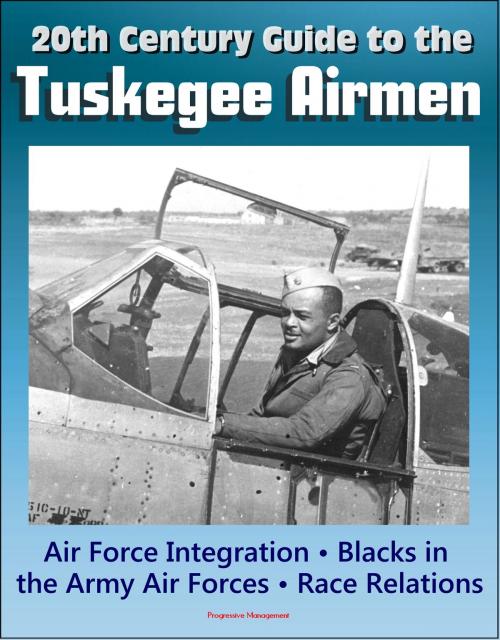20th Century Guide to the Tuskegee Airmen, Air Force Integration, Blacks in the Army Air Forces in World War II, Racial Segregation and Discrimination, African-American Race Relations in the Air Force
Nonfiction, History, Military, Aviation, Social & Cultural Studies, Political Science| Author: | Progressive Management | ISBN: | 9781476199931 |
| Publisher: | Progressive Management | Publication: | July 10, 2012 |
| Imprint: | Smashwords Edition | Language: | English |
| Author: | Progressive Management |
| ISBN: | 9781476199931 |
| Publisher: | Progressive Management |
| Publication: | July 10, 2012 |
| Imprint: | Smashwords Edition |
| Language: | English |
This comprehensive five-part history of the Tuskegee Airmen and Air Force integration efforts tells the story of the distinguished air crew and ground crew personnel associated with black flying units of the Army Air Forces (AAF) during World War II, along with extensive military histories documenting Air Force integration and race relations.
Contents: Introduction * Part 1: Tuskegee Airmen Chronology * Part 2: Chronological Table of Tuskegee Airmen Who Earned the Distinguished Flying Cross, By Date Of The Action For Which It Was Awarded * Part 3: Blacks in the Army Air Forces During World War II: The Problems of Race Relations * Part 4: The Air Force Integrates: 1945-1964.
During World War II, the U.S. military was racially segregated. Reflecting American society and law at the time, most black soldiers and sailors were restricted to labor battalions and other support positions. An experiment in the U.S. Army Air Forces, however, showed that given equal opportunity and training, African-Americans could fly in, command and support combat units as well as anyone. The USAAF's black fliers, the so-called "Tuskegee Airmen," served with distinction in combat and directly contributed to the eventual integration of the U.S. armed services, with the U.S. Air Force leading the way.
Blacks in the Army Air Forces During World War II: The Problems of Race Relations - This important account relates how the leadership in the War Department and the U.S. Army Air Forces (USAAF) tried to deal with the problem of race and the prejudices which were reflected in the bulk of American society. It tells a story of black racial protests and riots which such attitudes and discrimination provoked. The author describes many of the discriminatory actions taken against black airmen, whose goal was equality of treatment and opportunities as American citizens. He also describes the role of black pilots as they fought in the Mediterranean theater of operations against the Axis powers. In his final chapters, he examines the continuing racial frictions within the Army Air Forces which led to black servicemen protests and riots in 1945 at several installations. Despite these problems, the author concludes that the Army Air Forces made substantial progress in race relations and in opening up additional career opportunities for black airmen in the post-1945 period.
The Air Force Integrates: 1945-1964 - This book describes the struggle to desegregate the post-World War II U.S. Army Air Forces arid its successor, the U.S. Air Force, and the remarkable advances made during the next two decades to end racial segregation and move towards equality of treatment of Negro airmen. The author, Lt. Col. Alan L. Gropman, a former Instructor of History at the U.S. Air Force Academy, received his doctorate degree from Tufts University. His dissertation served as the basis for this volume. In it, the author describes the fight to end segregation within the Air Force following President Harry S. Truman's issuance of an executive order directing the integration of the armed forces. Despite resistance to this order, fueled by heated segregationist opposition, integration moved ahead somewhat slowly under the administration of President Dwight D. Eisenhower. Progress increased during the administration of President John F. Kennedy, which saw major advances toward achieving equality for Negro servicemen. Colonel Gropman's study is a detailed, comprehensive, and, in many respects, a documentary account. The crucial events it describes more than justify the unusually extended treatment they receive. The volume thus provides a permanent record of this turbulent period in race relations and constitutes a significant contribution to the history of the Air Force.
This comprehensive five-part history of the Tuskegee Airmen and Air Force integration efforts tells the story of the distinguished air crew and ground crew personnel associated with black flying units of the Army Air Forces (AAF) during World War II, along with extensive military histories documenting Air Force integration and race relations.
Contents: Introduction * Part 1: Tuskegee Airmen Chronology * Part 2: Chronological Table of Tuskegee Airmen Who Earned the Distinguished Flying Cross, By Date Of The Action For Which It Was Awarded * Part 3: Blacks in the Army Air Forces During World War II: The Problems of Race Relations * Part 4: The Air Force Integrates: 1945-1964.
During World War II, the U.S. military was racially segregated. Reflecting American society and law at the time, most black soldiers and sailors were restricted to labor battalions and other support positions. An experiment in the U.S. Army Air Forces, however, showed that given equal opportunity and training, African-Americans could fly in, command and support combat units as well as anyone. The USAAF's black fliers, the so-called "Tuskegee Airmen," served with distinction in combat and directly contributed to the eventual integration of the U.S. armed services, with the U.S. Air Force leading the way.
Blacks in the Army Air Forces During World War II: The Problems of Race Relations - This important account relates how the leadership in the War Department and the U.S. Army Air Forces (USAAF) tried to deal with the problem of race and the prejudices which were reflected in the bulk of American society. It tells a story of black racial protests and riots which such attitudes and discrimination provoked. The author describes many of the discriminatory actions taken against black airmen, whose goal was equality of treatment and opportunities as American citizens. He also describes the role of black pilots as they fought in the Mediterranean theater of operations against the Axis powers. In his final chapters, he examines the continuing racial frictions within the Army Air Forces which led to black servicemen protests and riots in 1945 at several installations. Despite these problems, the author concludes that the Army Air Forces made substantial progress in race relations and in opening up additional career opportunities for black airmen in the post-1945 period.
The Air Force Integrates: 1945-1964 - This book describes the struggle to desegregate the post-World War II U.S. Army Air Forces arid its successor, the U.S. Air Force, and the remarkable advances made during the next two decades to end racial segregation and move towards equality of treatment of Negro airmen. The author, Lt. Col. Alan L. Gropman, a former Instructor of History at the U.S. Air Force Academy, received his doctorate degree from Tufts University. His dissertation served as the basis for this volume. In it, the author describes the fight to end segregation within the Air Force following President Harry S. Truman's issuance of an executive order directing the integration of the armed forces. Despite resistance to this order, fueled by heated segregationist opposition, integration moved ahead somewhat slowly under the administration of President Dwight D. Eisenhower. Progress increased during the administration of President John F. Kennedy, which saw major advances toward achieving equality for Negro servicemen. Colonel Gropman's study is a detailed, comprehensive, and, in many respects, a documentary account. The crucial events it describes more than justify the unusually extended treatment they receive. The volume thus provides a permanent record of this turbulent period in race relations and constitutes a significant contribution to the history of the Air Force.















